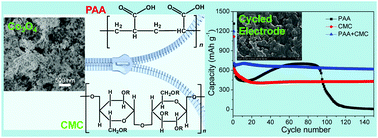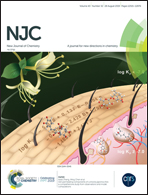Aqueous binder effects of poly(acrylic acid) and carboxy methylated cellulose on anode performance in lithium-ion batteries†
Abstract
The binder effect of poly(acrylic acid) (PAA) and carboxy methylated cellulose (CMC) is investigated based on a metal oxide anode (e.g., Co3O4), which was prepared from metal nitrate decomposition without further engineering on the nanostructures and carbon modification. We find that the combined binder of PAA and CMC has a good coupling contribution to the electrochemical performance. Distinct from the traditional approaches pursuing advanced structures and/or carbon modification, the presented strategy herein is more convenient, environment-friendly and available for industrial production. For example, the model of Co3O4 can exhibit an extremely high capacity of 700 mA h g−1 at the current density of 200 mA g−1 and a reversible capacity over 620 mA h g−1 beyond 150 cycles. In addition, a model of full batteries employing a pre-lithiated Co3O4 anode versus a LiNi1/3Co1/3Mn1/3O2@AlPO4 cathode with a higher energy density is studied, demonstrating the availability of the presented PAA/CMC binder towards commercialization. Thus, we conclude that the combined aqueous binder of PAA/CMC can have a positive effect on the electrochemical performance of the metal oxide anodes in lithium (ion) batteries, which may be extended further to other advanced metal-ion (Na+, Mg2+, Al3+, etc.) batteries.



 Please wait while we load your content...
Please wait while we load your content...